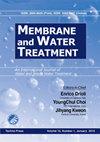Hybrid neutralization and membrane process for fluoride removalfrom an industrial effluent
IF 1.1
4区 工程技术
Q4 ENGINEERING, CHEMICAL
引用次数: 1
Abstract
This study aims to investigate at a laboratory scale fluorides removal from an industrial wastewater having excessive F- concentration through a hybrid process combining neutralization and membrane separation. For the membrane separation operation, both Reverse Osmosis (RO) and Nanofiltration (NF) were investigated and confronted. The optimized neutralization step with hydrated lime allowed reaching fluoride removal rates of 99.1 ± 0.4 %. To simulate continuous process, consecutive batch treatments with full recirculation of membrane process brines were conducted. Despite the relatively high super saturations with respect to CaF2, no membrane cloaking was observed. The RO polishing treatment allowed decreasing the permeate fluoride concentration to 0.9 ± 0.3 mg/L with a fluoride rejection rate of 93± 2% at the optimal transmembrane pressure of around 100 psi. When NF membrane was used to treat neutralization filtrate, the permeate fluoride concentration dropped to 1.1± 0.4 mg/L with a fluoride rejection rate of 88± 5% at the optimal pressure of around 80 psi. Thus, with respect to RO, NF allowed roughly 20% decrease of the driving pressure at the expense of only 5% drop of rejection rate. Both NF and RO permeates at optimal operating transmembrane pressures respect environmental regulations for reject streams discharge into the environment.混合中和膜法去除工业废水中的氟化物
本研究旨在研究中和与膜分离相结合的混合工艺对含氟高浓度工业废水的除氟效果。对于膜分离操作,研究了反渗透(RO)和纳滤(NF)两种方法。优化后的水合石灰中和步骤可使氟去除率达到99.1±0.4%。为了模拟连续过程,对膜法盐水进行了全循环连续批处理。尽管相对较高的CaF2超饱和度,但未观察到膜隐没。在100 psi左右的最佳跨膜压力下,反渗透抛光处理可将渗透氟化物浓度降低至0.9±0.3 mg/L,氟截留率为93±2%。当采用纳滤膜处理中和滤液时,在最佳压力为80 psi左右时,渗透氟浓度降至1.1±0.4 mg/L,氟截留率为88±5%。因此,相对于RO, NF允许大约20%的驱动压力下降,而拒绝率仅下降5%。NF和RO在最佳的操作跨膜压力下都能渗透,这符合排放到环境中的污水流的环境法规。
本文章由计算机程序翻译,如有差异,请以英文原文为准。
求助全文
约1分钟内获得全文
求助全文
来源期刊

Membrane Water Treatment
ENGINEERING, CHEMICAL-WATER RESOURCES
CiteScore
1.90
自引率
30.00%
发文量
0
审稿时长
>12 weeks
期刊介绍:
The Membrane and Water Treatment(MWT), An International Journal, aims at opening an access to the valuable source of technical information and providing an excellent publication channel for the global community of researchers in Membrane and Water Treatment related area. Specific emphasis of the journal may include but not limited to; the engineering and scientific aspects of understanding the basic mechanisms and applying membranes for water and waste water treatment, such as transport phenomena, surface characteristics, fouling, scaling, desalination, membrane bioreactors, water reuse, and system optimization.
 求助内容:
求助内容: 应助结果提醒方式:
应助结果提醒方式:


